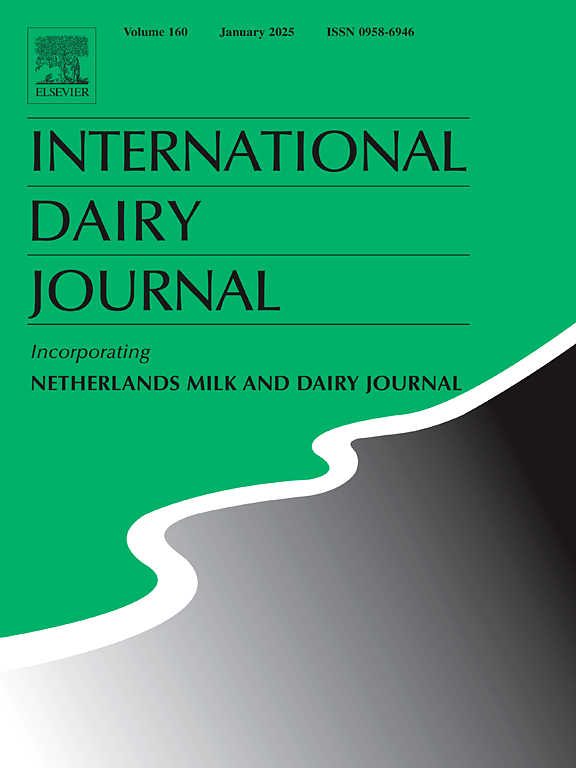体细胞计数和泌乳期对挪威山羊单山羊乳凝特性的影响
IF 3.1
3区 农林科学
Q2 FOOD SCIENCE & TECHNOLOGY
引用次数: 0
摘要
本研究探讨了体细胞计数(SCC)和泌乳期对挪威羊奶凝血特性和乳成分的影响。在哺乳期间每月抽样40只山羊,评估凝乳酶凝固时间(RCT)、凝乳凝固时间(k20)、凝乳硬度(a30)和乳成分(如乳糖、蛋白质和矿物质)。结果表明,SCC水平高于2000 × 10³cells mL - 1显著延迟RCT,降低a30,而k20不受影响。观察到SCC、牛奶成分(如乳糖和矿物质)和凝固特性之间存在很强的相关性,SCC升高与凝乳形成受损和蛋白质降解增加有关。泌乳阶段也会影响奶质,泌乳中期凝血性能较差,特别是在山地放牧期间。这些发现强调了监测SCC和哺乳期对于维持最佳凝血特性和确保稳定的奶酪生产的关键作用。本文章由计算机程序翻译,如有差异,请以英文原文为准。
Impact of somatic cell count and lactation stage on coagulation properties of milk from Norwegian individual goats
This study explores the impact of somatic cell count (SCC) and lactation stage on the coagulation properties and milk composition of Norwegian goat milk. Monthly sampling of forty goats throughout lactation assessed rennet coagulation time (RCT), curd firming time (k20), curd firmness (a30), and milk components such as lactose, protein, and minerals. Results demonstrated that SCC levels above 2000 × 10³ cells mL−1 significantly delayed RCT and reduced a30, while k20 remained unaffected. A strong correlation was observed between SCC, milk composition (such as lactose and minerals), and coagulation properties, with elevated SCC linked to impaired curd formation and increased protein degradation. The lactation stage also influenced milk quality, with mid-lactation showing poorer coagulation performance, particularly during mountain grazing. These findings underscore the critical role of monitoring SCC and lactation stage to maintain optimal coagulation properties and ensure stable cheese production.
求助全文
通过发布文献求助,成功后即可免费获取论文全文。
去求助
来源期刊

International Dairy Journal
工程技术-食品科技
CiteScore
6.50
自引率
9.70%
发文量
200
审稿时长
49 days
期刊介绍:
The International Dairy Journal publishes significant advancements in dairy science and technology in the form of research articles and critical reviews that are of relevance to the broader international dairy community. Within this scope, research on the science and technology of milk and dairy products and the nutritional and health aspects of dairy foods are included; the journal pays particular attention to applied research and its interface with the dairy industry.
The journal''s coverage includes the following, where directly applicable to dairy science and technology:
• Chemistry and physico-chemical properties of milk constituents
• Microbiology, food safety, enzymology, biotechnology
• Processing and engineering
• Emulsion science, food structure, and texture
• Raw material quality and effect on relevant products
• Flavour and off-flavour development
• Technological functionality and applications of dairy ingredients
• Sensory and consumer sciences
• Nutrition and substantiation of human health implications of milk components or dairy products
International Dairy Journal does not publish papers related to milk production, animal health and other aspects of on-farm milk production unless there is a clear relationship to dairy technology, human health or final product quality.
 求助内容:
求助内容: 应助结果提醒方式:
应助结果提醒方式:


